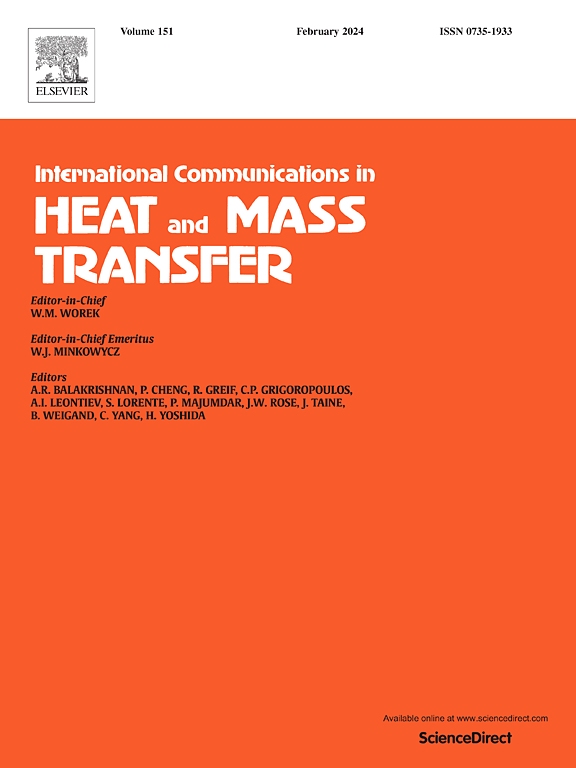Correlations of condensation heat transfer in hydrophobic enhanced tubes with using R32
IF 6.4
2区 工程技术
Q1 MECHANICS
International Communications in Heat and Mass Transfer
Pub Date : 2025-03-30
DOI:10.1016/j.icheatmasstransfer.2025.108886
引用次数: 0
Abstract
An experimental study of condensation heat transfer is performed in enhanced surface stainless steel tubes using refrigerant R32. An evaluation of the effect of hydrophobicity on condensation heat transfer is accomplished by comparing the performance of three enhanced tubes (hydrophobic (HYD), herringbone (HB), and hydrophobic/herringbone composite (HYD/HB)) to one smooth tube. Parameters include: saturation temperatures of 35 °C and 45 °C; mass flow rates of 100 kg/(m2·s) and 150 kg/(m2·s); and vapor qualities in the range from 0.2 to 0.9. A new condensation flow heat transfer correlation is established based on hydrophobicity and flow pattern analysis. The results indicate: (i) for varying mass flow rates, the HB tube exhibits superior heat transfer performance compared to the HYD and HYD/HB tube; (ii) as vapor quality increases, the HTC of the HYD tube gradually increases and becomes equal to that of the HB tube; (iii) for a vapor quality above 0.6, the HYD tube outperforms the HB tube. Five condensation flow HTC models are evaluated; experimental values were compared and analyzed with the calculated results in order to investigate the condensation flow heat transfer mechanism of enhanced tubes. Condensation flow heat transfer correlations in HYD, HB, and HYD/HB can predict data points within ±20 % including 80 % of the data points, and within ±25 % including 93 % of the data points.
疏水强化管内冷凝换热与R32的关系
采用R32制冷剂对强化表面不锈钢管内冷凝换热进行了实验研究。通过比较三种增强管(疏水管(HYD)、人字形管(HB)和疏水/人字形复合管(HYD/HB))与光滑管的性能,评估了疏水对冷凝传热的影响。参数包括:饱和温度为35℃和45℃;质量流量分别为100 kg/(m2·s)和150 kg/(m2·s);蒸汽质量在0.2到0.9之间。基于疏水性和流型分析,建立了一种新的冷凝流换热关系式。结果表明:(1)在不同的质量流量下,HB管的传热性能优于HYD管和HYD/HB管;(ii)随着蒸汽质量的增加,HYD管的HTC逐渐增大,与HB管的HTC趋于相等;(iii)对于高于0.6的蒸汽质量,HYD管优于HB管。对五种凝流HTC模型进行了评价;将实验值与计算结果进行对比分析,探讨强化管的冷凝流动换热机理。HYD、HB和HYD/HB的冷凝流动传热相关性可以预测±20%以内的数据点,包括80%的数据点,±25%以内的数据点包括93%的数据点。
本文章由计算机程序翻译,如有差异,请以英文原文为准。
求助全文
约1分钟内获得全文
求助全文
来源期刊
CiteScore
11.00
自引率
10.00%
发文量
648
审稿时长
32 days
期刊介绍:
International Communications in Heat and Mass Transfer serves as a world forum for the rapid dissemination of new ideas, new measurement techniques, preliminary findings of ongoing investigations, discussions, and criticisms in the field of heat and mass transfer. Two types of manuscript will be considered for publication: communications (short reports of new work or discussions of work which has already been published) and summaries (abstracts of reports, theses or manuscripts which are too long for publication in full). Together with its companion publication, International Journal of Heat and Mass Transfer, with which it shares the same Board of Editors, this journal is read by research workers and engineers throughout the world.

 求助内容:
求助内容: 应助结果提醒方式:
应助结果提醒方式:


